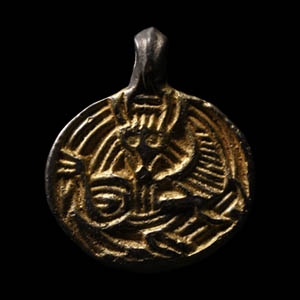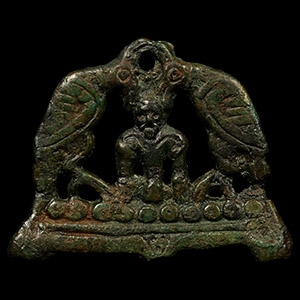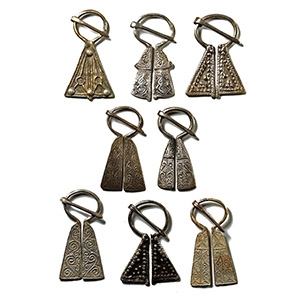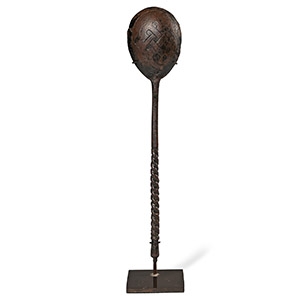Home > Auctions > 26 November - 1 December 2024
Ancient Art, Antiquities, Natural History & Coins
Acquired on the London art market in the late 1980s-1990s.
From the family collection of an East London, UK, gentleman.
Private collection formed in Europe in the 1980s.
Westminster collection, central London, UK.
From the private collection of a London gentleman, from his grandfather's collection formed before the early 1970s.
This lot has been checked against the Interpol Database of stolen works of art and is accompanied by a search certificate number no.12435-225923.
Cf. Arbman, H., Birka I: Die Gräber, Uppsala, 1940, pl.144.
The image of Óðinn (Odin) with his ravens Huginn and Muninn appears widely in the Viking world, and is mentioned in the Icelandic poem collection Poetic Edda and elsewhere. The two birds fly around the world collecting news and then report it to the god in the evening. He says that he fears the ravens may not return from their flight: since their names mean 'thought' and 'memory', the meaning of the verse is that the god is anxious about the loss of these faculties.
UK collection, previously acquired in the 1980s.
Property of a Canadian collector living in Ontario; acquired 2018.
Cf. Franceschi, G., Asger, J. & Magnus, B., Mennesker, Guder og Masker i Nordisk Jernalderkunst, Bind 1, Silkeborg, 2005, figs.130-1.
UK gallery, acquired in the 2000s.
Property of an English gentleman.
This lot has been checked against the Interpol Database of stolen works of art and is accompanied by search certificate no.11406-192532.
Cf. MacGregor, A. et al., A Summary Catalogue of the Continental Archaeological Collections, Oxford, 1997, item 1.9; and cf. Hammond, A.B., Benet's Artefacts of England & the United Kingdom, Fourth Edition, 2021, p.497, VO7-42257, for a similar item valued at £8,000-£10,000.
The type is known as a 'drum' brooch or 'box' brooch. They were apparently manufactured on the island of Gotland and all known examples probably have their origin there. Over time, the refinement of the earlier types (such as the present example) is superseded by cruder decoration consisting of dimples or simple dots.
Found Suffolk, UK.
From an old private collection of Norfolk, UK, gentleman, formed since 1998.
Cf. Williams, D., Late Saxon Stirrup-Strap Mounts, York, 1997, item 180, for type.
Acquired in London, 1985.
Private collection, London.
This lot has been checked against the Interpol Database of stolen works of art and is accompanied by a search certificate number no.12436-226869.
Cf. a similar bracelet in silver from Orupgård, Denmark, published in Franceschi, G., Asget, J. & Magnus, B. Fuglen, Dyret og Mennesket in Nordisk Jernalderkunst, vol.2 item 1; also Sedov, B.B., Finno-Ugri i Balti v Epokhi Srednevekovija, Moscow, 1987, pl.XLV (9), for type.
Acquired on the European art market since the early 2000s.
From the private Northern Ireland collection of R.M.
See Sedov, B.B., Finno-Ugri i Balti v Epokhi Srednevekovija, Moscow, 1987, pl.XLIV, item 11.
This type of brooch belongs to the typologies of the omega brooches. It was probably used by Ugro-Finnic people to fasten the shirt at the neck or to attach other lighter garments. These brooches evolved to become very elaborate, with dangling springs from the edges, and were often worn in pairs, particularly on female garments. In this late Viking period their coins demonstrated Russian and Eastern Roman influences in their art and jewellery.
Acquired in 1997.
Private collection, Europe.
This lot has been checked against the Interpol Database of stolen works of art and is accompanied by a search certificate number no.12437-226708.
Cf. Makarov, N.A. ed., Rus v IX-X Vekach: Archeologicheskaya Panorama, Moscow, 2012, p.332, items 2-3; Arbman, H., Birka I: Die Gräber, Uppsala, 1940, pl.98(13) for similar examples.
Acquired on the European art market since the early 2000s.
From the private Northern Ireland collection of R.M.
See Sedov, B.B., Finno-Ugri i Balti v Epokhi Srednevekovija, Moscow, 1987, for similar items.
Acquired on the London art market, 1995.
Private collection, London.
Cf. Fodor, I., The Ancient Hungarians, Budapest, 1996, p. 369.
The lattice motif has parallels in the art of the Vars and other cultures of the Hungarian plain. Scandinavian contact with that part of Europe was maintained by trade and settlement along the Volga and other waterways. The city of Kyiv was ruled by Scandinavian Rus for some centuries.
Found near Thetford, Norfolk, UK, circa 2018.
Property of a private collector, West London, UK.
Cf. Youngs, S. (ed.), The Work of Angels. Masterpieces of Celtic Metalwork, 6th-9th centuries AD, London, 1989, items 53, 54, for type.
253 - 264 of 3419 LOTS




.jpg)
.jpg)
.jpg)
.jpg)




.jpg)



